By: Foluke Akinwalere. Freelance Health Writer. With medical review and editorial support by the DLHA Team
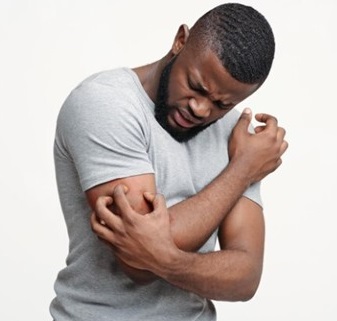
Young black man scratching his itching right arm with his left hand
Tinea infections, commonly referred to as ringworm, are infections of the skin, hair, or nails caused by fungi called dermatophytes. These infections are prevalent worldwide, affecting individuals of all ages and ethnicities. Tinea infections are one of the 5 common skin diseases in Africa. However, there are specific variations and considerations when examining the occurrence and management of tinea infections in individuals of African descent.
In Africa, factors such as climate, socio-economic conditions, and cultural practices can influence the prevalence and presentation of these infections. Therefore, understanding the specific patterns of tinea infections in African populations is crucial for effective diagnosis, treatment, and prevention strategies.
This article aims to explore the various aspects of tinea infections in African populations, including causes, types, clinical presentation, risk factors, diagnostic methods, and treatment. When healthcare providers and the general population in the region are aware and educated about the specific characteristics of tinea infections, they can improve their capacity to provide tailored and culturally appropriate care to those affected. Furthermore, the people afflicted by the infections will be better informed about their condition and participate effectively with their provider on care management.
The primary causative organism of tinea infections is dermatophyte fungi belonging to the genera Trichophyton, Microsporum, and Epidermophyton. These fungi have the ability to invade the skin, hair, and nails, leading to various types of tinea infections depending on the affected area.
Some dermatophytes are spread from person to person (anthropophilic organisms), while others come from the soil and are transmitted to humans (geophilic organisms). Some dermatophytes are also spread to humans from animals (zoophilic organisms).
Direct Contact: Tinea infections are highly contagious and can be transmitted through direct contact with infected individuals, animals, or contaminated objects such as towels, combs, or clothing. Close contact sports, shared living spaces, and communal bathing areas can facilitate the transmission of these fungi. [2]
Warm and Humid Environments: Dermatophyte fungi thrive in warm and moist environments, that is why tinea infections are more common in tropical and subtropical regions, which is the climate in most regions of the continent of Africa. [2] Excessive sweating or prolonged moisture on the skin can create an ideal environment for fungal growth and increase the risk of infection.
Compromised Skin Barrier: Any condition that weakens or damages the skin barrier such as cuts, abrasions, or other skin diseases, can increase susceptibility to tinea infections. People with compromised immune systems, diabetes, or obesity are also at higher risk of developing these fungal infections.
Poor Hygiene: Inadequate personal hygiene practices, such as infrequent handwashing or sharing personal items with infected individuals, can contribute to the spread of tinea infections. Maintaining good hygiene and avoiding close contact with infected individuals are important preventive measures.
Tinea infections can manifest in various forms affecting different parts of the body. The common types of tinea infections are:
Other types include:
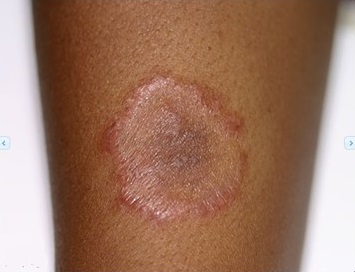
Tinea Corporis. Image Credit
Tinea Corporis, commonly known as ringworm, affects the skin and typically appears as circular or ring-shaped patches with raised edges. It can occur on any part of the body and is often itchy. Ringworm can spread through direct contact with infected people, animals, or contaminated objects.
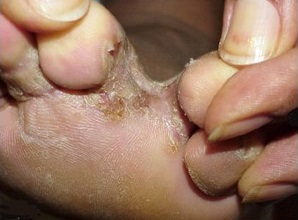
Tinea Pedis (Athlete's foot). Image Credit
Tinea Pedis (athlete’s foot), is a fungal infection of the feet, particularly between the toes. It causes itching, burning, scaling, and sometimes blisters. Athlete’s foot thrives in warm, moist environments like sweaty shoes and gym locker rooms. It can spread through direct contact with contaminated surfaces.
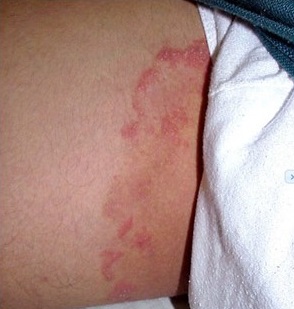
Tinea Cruris. Image Credit
Tinea cruris, or jock itch, affects the groin and inner thighs. It presents as red, itchy, and often circular rashes spreading from the groin area. This infection is common in athletes and individuals who sweat heavily in the groin area. Jock itch can spread through close skin-to-skin contact.
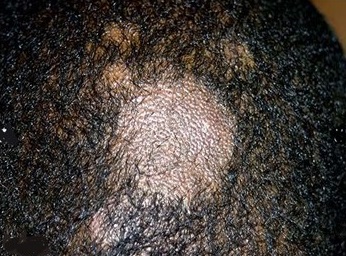
Tinea Capitis (Scalp ringworm). Image Credit
Tinea capitis is a fungal infection of the scalp and hair shafts, primarily affecting children but can also occur in adults. It causes scaling, hair loss, and bald patches on the scalp. Tinea capitis is highly contagious and can spread through combs, hats, or close contact with infected individuals.
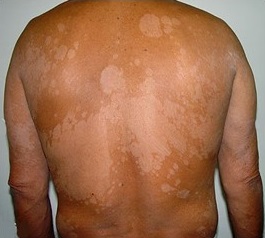
Tinea Versicolor (Pityriasis Versicolor). Image Credit
Tinea versicolor, also known as pityriasis versicolor, is a fungal infection of the skin that leads to discoloured patches, often lighter or darker than the surrounding skin. These patches can appear on the chest, back, neck, and arms. Tinea versicolor is more noticeable in hot and humid climates and is caused by Malassezia fungi that naturally reside on the skin.
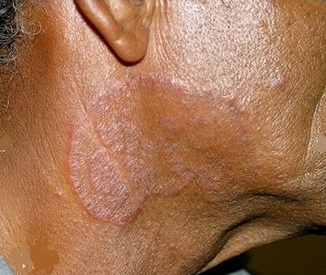
Tinea Faciei. Image Credit
Tinea facial is a fungal infection of the face, typically characterised by red, scaly patches that may have well-defined borders. It can be mistaken for other skin conditions like eczema or psoriasis. Tinea faciei is contagious just by touch and can spread easily to all regions of skin.
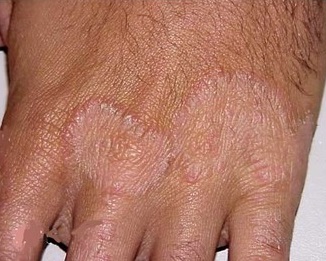
Tinea Manuum. Image Credit
Tinea manuum refers to a fungal infection of the hand, often affecting the palm or between the fingers. It is a superficial dermatophyte infection of one or both hands. [3] It presents as red, itchy patches with scaling or blisters. Treatment usually involves topical antifungal creams or ointments applied to the affected areas.
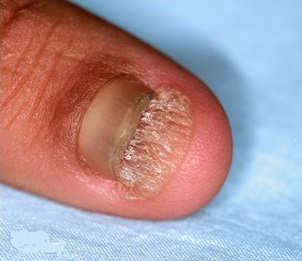
Tinea Unguium (Onychomycosis). Image Credit
Tinea unguium, also known as onychomycosis, is a fungal infection of the nails, causing thickened, discolored, and brittle nails. This condition may affect toenails or fingernails, but toenail infections are particularly common. It occurs in about 10% of the adult population. [4] Its risk factors include aging, diabetes, poorly fitting shoes, and the presence of tinea pedis. Due to the costly and lengthy treatment required for tinea unguium (three to four months for fingernails infections and four to six months for toenail infections), it is important to confirm the diagnosis before treatment is initiated. [5]
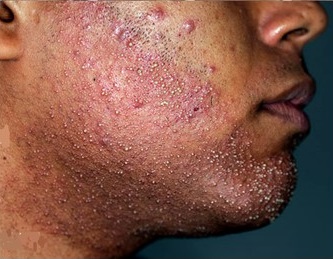
Tinea sycosis
Tinea barbae is a dermatophyte infection that affects the bearded and mustache areas of the face, primarily in older adolescent and adult males. It is also known as tinea sycosis and barber’s itch. Tinea barbae is usually very inflamed with red lumpy areas, pustules and crusting around the hairs (kerion) similar to bacterial folliculitis. It is often seen in cattle farmers as an occupational hazard.
Treatment of tinea barbae involves using warm compresses to remove crusts and prescribing topical or oral antibiotics to treat any secondary bacterial infections. The primary treatment is an oral antifungal medication, and with proper care, the condition typically resolves within 4 to 6 weeks. [1]
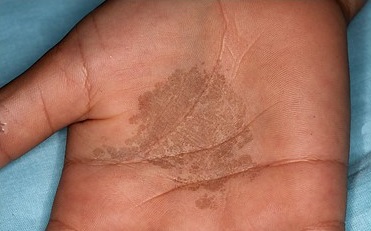
Tinea Nigra (Palm of hand and Sole of feet). Image Credit
Tinea nigra is a superficial fungal infection that causes dark brown to black patches on the palms of the hands or soles of the feet. This type of infection is usually painless and can be treated with topical antifungal agents.
Tinea infections can be influenced by various risk factors, especially in African populations. Due to factors such as inadequate social, economic, healthcare, and hygiene practices, tinea capitis is more common among children. [5] The commonest risk factors include poor living conditions, interaction patterns, lack of sanitation, crowded housing, limited water supply, and poor health-seeking behaviour. People who have pets, wet skin conditions, skin injuries, use public showers, go barefoot, and share hair brushes or unwashed clothing with others are also more susceptible to the condition. Other factors include:
The warm and humid climate prevalent in many regions of Africa creates an ideal environment for fungal growth, including dermatophyte fungi responsible for tinea infections. High temperatures and humidity promote sweating, which can contribute to the persistence and spread of fungal infections on the skin, scalp, or nails.
Individuals with compromised immune systems, such as those living with HIV/AIDS or undergoing immunosuppressive therapy, are more susceptible to tinea infections. A weakened immune response diminishes the body’s ability to fight fungal pathogens, allowing dermatophyte fungi to grow rapidly and cause infections more readily.
Close contact with individuals already infected with tinea infections increases the risk of transmission. This is particularly common in households, schools, sports facilities, and other communal settings where direct skin-to-skin contact or sharing of personal items like clothing and grooming tools can facilitate the spread of fungal infections.
Tinea infections present with distinct symptoms and can be diagnosed through various methods.
The common symptoms of tinea Infections include:
The diagnosis of tinea infections invloves the following processes:
Healthcare providers can often diagnose tinea infections based on the history and appearance of the skin, nails, or scalp. They look for characteristic signs like ring-shaped rashes, scaling, and inflammation.
Skin scrapings or nail clippings from the affected area may be examined under a microscope to detect fungal elements like hyphae or spores. This helps confirm the presence of dermatophyte fungi.
Fungal cultures involve collecting a sample from the affected area and growing it in a laboratory to identify the specific type of fungus causing the infection. This method is particularly useful for diagnosing difficult or recurrent cases of tinea Infections.
Diagnostic methods may vary depending on the clinical presentation and severity of the infection. Prompt and accurate diagnosis is essential for initiating appropriate treatment.
It is important to consult a healthcare professional for proper evaluation and management of tinea infections to prevent complications and ensure effective treatment of symptoms.
Tinea infections can be effectively treated using various antifungal medications and preventive measures.
Over-the-counter (OTC) or prescription-strength antifungal creams containing ingredients like clotrimazole, miconazole, terbinafine, or ketoconazole are commonly used to treat tinea infections. These medications are applied directly to the affected skin, nails, or scalp.
Antifungal sprays or powders can help keep affected areas dry and treat infections, especially those affecting the feet (Tinea pedis) or groin (tinea cruris).
In cases of severe or widespread tinea infections, oral antifungal medications such as terbinafine, itraconazole, or fluconazole may be prescribed by a healthcare provider. These medications work systemically to eliminate fungal infections from within.
Maintain good personal hygiene, including regular bathing and washing of hands and feet with soap and water.
Especially after sweating or showering. Avoid wearing tight-fitting clothing that can trap moisture.
Do not share towels, clothing, socks, shoes, or other personal items with others, especially if someone in the household has a tinea infection.
Apply antifungal powders or creams to susceptible areas, such as geet and groin, to prevent fungal growth and recurrence of tinea infections.
Wash clothing, socks, bedding, and towels in hot water and dry them thoroughly to kill any fungi present and prevent reinfection.
Combining appropriate treatment with preventing measures is essential for managing tinea infections effectively and reducing the risk of recurrence. It is important to follow the advice of healthcare professionals and complete the full course of prescribed medications to ensure complete resolution of the fungal infection. If symptoms persist or worse despite treatment consult a healthcare provider for further evaluation and management.
Tinea infections, if left untreated or inadequately managed, can lead to complications such as:
Untreated tinea infections can spread to other parts of the body or to other individuals through direct contact or sharing of personal items. This can result in more extensive and difficult-to-treat fungal infections.
Persistent tinea infections can weaken the skin barrier, making it more susceptible to secondary bacterial infections. These infections may require additional medical intervention, such as antibiotics.
Some individuals may experience chronic or recurrent tinea infections, especially if predisposing factors like poor hygiene or underlying health conditions are not addressed.
Certain types of tinea infections, such as tinea versicolor, can cause permanent changes in skin pigmentation or texture if left untreated for extended periods.
Severe or persistent tinea infections, particularly those affecting visible areas like the face or scalp, can have a negative impact on self-esteem and quality of life.
However, the outcome of proper treatment of tinea infections include:
With appropriate antifungal treatment, most tinea infections resolve within weeks to months. Symptoms such as itching, redness, scaling, and rash typically improve significantly.
Completing the prescribed course of antifungal medications and adopting preventive measures (e.g. good hygiene practices, avoiding sharing personal items) can help prevent recurrence of tinea infections.
Treatment of tinea infections not only resolves the current infection but also promotes overall skin health by restoring the skin’s natural barrier function.
The prognosis for tinea infections is generally excellent with proper treatment and adherence to preventive measures. Most individuals experience complete resolution of symptoms and do not encounter long-term complications.
Early intervention and proactive management contribute to favorable outcomes and improved quality of life for individuals affected.
To combat the spread of tinea infections in Africa communities, education plays a vital role. By raising awareness about the causes, symptoms, and preventive measures of tinea infections, individuals can take proactive steps to protect themselves and their families. Proper hygiene practices, such as regular bathing, keeping skin dry, and avoiding shared personal items, can significantly reduce the risk of fungal infections. Furthermore, empowering healthcare providers with the knowledge and tools to diagnose and treat tinea infections effectively is essential. Access to affordable antifungal medications and dermatological care can improve outcomes and prevent complications associated with untreated tinea infections.
5 Common Skin Diseases in Africa
10 Common HIV Skin Conditions In Africans And Their Treatments
Published: April 30, 2024
© 2024. Datelinehealth Africa Inc. All rights reserved.
Permission is given to copy, use and share content for non-commercial purposes without alteration or modification and subject to source attribution.
DATELINEHEALTH AFRICA INC., is a digital publisher for informational and educational purposes and does not offer personal medical care and advice. If you have a medical problem needing routine or emergency attention, call your doctor or local emergency services immediately, or visit the nearest emergency room or the nearest hospital. You should consult your professional healthcare provider before starting any nutrition, diet, exercise, fitness, medical or wellness program mentioned or referenced in the DatelinehealthAfrica website. Click here for more disclaimer notice.